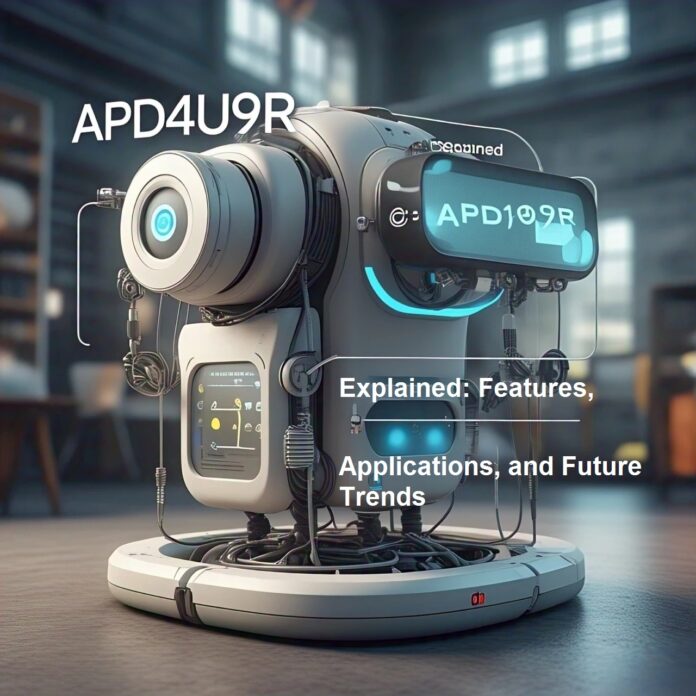The Focus Technology Sector Is Constantly Adapting
One of the most captivating emerging technologies in recent years APD4U9R. If you are a developer, a businessperson, or someone interested in novel tech, APD4U9R is of basic importance. This article focus on what APD4U9R is, its main attributes, its multi-industry applications, and the possible future trends that could influence its development.
APD4U9R: What Exactly Is It?
The technological framework APD4U9R is designed to improve the computational efficiency of systems, performance optimization, and security enhancement. Its origin and development are still a guarded secret among industry stakeholders. However, what APD4U9R is known for is the fact that it can be easily combined with the existing modern computing infrastructures.
APD4U9R Key Features
- Enhanced Computational Efficiency: The novel algorithms employed in APD4U9R Advanced Computing make sure that its processing speeds are optimized. This makes functioning in high-performance computing a breeze.
- Scalability: APD4U9R is unrivaled when it comes to operating on different devices ranging from small devices to enterprise level systems.
- Security and Encryption: Built-in features ensure data protection which makes it reliable for applications needing tough cybersecurity measures.
- AI and Machine Learning Integration: The support of AI and ML allows for smarter decision making and automation for APD4U9R.
- Cloud Compatibility: The APD4U9R Aritifical Processing Unit works well within a cloud computing environment, meaning that the framework is designed to work without difficulty in terms of remote accessibility and flexibility.
- Energy Efficiency: As opposed to conventional computing systems, the APD4U9R employs methods that consume less energy while also performing in a highly effective manner.
- Customizability: APD4U9R can be altered by its developers in order to suit certain preferences. This characteristic enables the tool to be used in a variety of different industries.
Applications of APD4U9R
1. Artificial Intelligence and Machine Learning
APD4U9R works well with AI algorithms and ML Apriori algorithms making it a popular selection for industries that utilize predictive analytics, automation, and intelligent decisions.
2. Cybersecurity
The sophisticated encryption and secure processing of APD4U9R makes it very important when it comes to protecting sensitive information from cyber threats.
3. Financial Sector
APD4U9R is used by most banks and financial institutions to improve transaction processing speed, enhance security, and automate risk evaluation.
4. Healthcare and Biotechnology
Medical research is done using APD4U9R. Managing patient data and discovering drugs is also done using set APD4U9R which increases the efficiency and precision of these processes.
5. Internet of Things (IoT)
Smart homes, industrial automation, and other connected devices use APD4U9R because it offers the security and adaptability needed with IoT devices that require data processing, real time data processing, and data transmitting.
6. Cloud Computing And Data Centers
With the diversification of technologies APD4U9R, the cloud compatibility feature enforcing appropriate or orderly computing, information retrieval, or storage update procedures helps with effective digital storage and retrieval information on the cloud.
7. Robotics and Automotive Systems
Autonomous or self-driving vehicles along with AI-enabled intelligent transport systems make use of APD4U9R for skilled real-time data processing to guarantee accuracy and reliability in safety and rationality.
Future Directions of APD4U9 R
- Assurance of Integration Alongside Quantum Computing: Later models of APD4U9R are expected to incorporate elements of quantum computing logic which would greatly enhance parallel processing power.
- Advances of AI & ML: Such anticipated changes consider that the evolution in Artificial Intelligence and Machine Learning will drive the further development of APD4U9R to handle more sophisticated automated systems and higher order algorithms.
- More Prolific Use for Edge Computing: The advancement of edge computing may set a benchmark for APD4U9R as an advanced processor that works close to the data source instead of operating under the cloud computing server.
- Improved Protection Protocols: It would be the case that most if not all modern cyber threats would do away with APD4U9R’s protective measures hence giving means for more sophisticated measures.
- Called it Green Sustainable Informatics Engineering: These precise computing technologies might be interested to know that there is a significant focus on APD4U9R capturing cleaner technologies due to the shift towards green sustainable initiatives.
- Adoption in 5G and Beyond: The APD4U9R architecture described is well suited with the requirements posed by 5G and expected advances in telecommunication due to its high speed and low latency features.
Final Thought
With unmatched efficiency, security, and scalability, APD4U9R marks a new evolutionary step in computation. Understanding its features is vital for developers and businesses that aim to get a competitive edge and dominate the technology space. The future of APD4U9R looks encouraging as AI, quantum computing, and cybersecurity advances are set to influence its trajectory.
Commonly Asked Questions
1. What does APD4U9R stand for?
As a proprietary framework, its naming structure follows specific guidelines. APD4U9R does not disclose the meaning of its name but does claim it to be an innovative methodology to achieve computer efficiency.
2. Is APD4U9R an open source technology?
Whether APD4U9R is open source or not depends on the implementation in question. Some versions of it can be made public, while others remain scope restricted under enterprise solutions.
3. In what ways does APD4U9R improve cybersecurity?
APD4U9R provides additional security measures employing advanced encryption protocols. These aid in data protection and lowering the chances of malicious cyber threat exposure.
4. Can APD4U9R work with other systems?
Absolutely, APD4U9R is known for its compatibility. Clouds, AI frameworks, and IoT devices are just some of the infrastructures that it seamlessly works with.
5. What industries benefit the most from APD4U9R?
AI, cybersecurity, IoT, autonomous systems, finance, and healthcare reap the maximum benefits from the advanced features of APD4U9R.
6. Why is APD4U9R different compared to other computing models?
The efficiency, security, AI integration, and cloud compatibility features makes APD4U9R a next-generation computational framework.
7. In what ways does APD4U9R help in sustainability issues?
With the design that APD4U9R has, it is considered energy efficient. It reduces power consumption without affecting performance, which helps green computing initiatives.
8. What are the most advanced changes expected in APD4U9R?
Future developments might consist of integrating quantum computing, expanding AI features, improved edge computing applications, and enhancing security.
9. Can small businesses use APD4U9R?
Definitely. Its scaling capabilities makes APD4U9R suitable for small and larger responds to various industries and enterprises.
10. Where can I find additional facts about APD4U9R?
For the best follow up with APD4U9R, check out the industry whitepapers, research articles, and developer forums to explore further.


